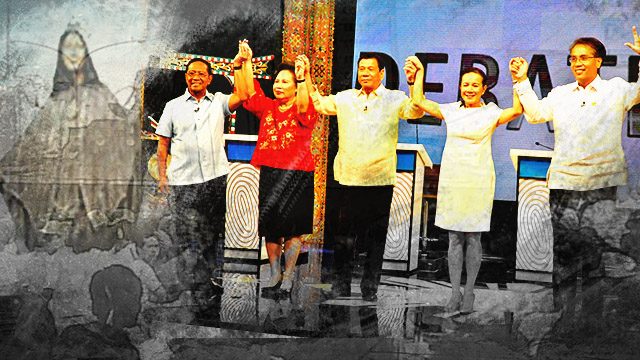SUMMARY
This is AI generated summarization, which may have errors. For context, always refer to the full article.

MANILA, Philippines – Three decades ago, the Philippines unseated dictator Ferdinand Marcos through a bloodless revolution that placed the country in the global spotlight in February 1986. The EDSA People Power Revolution, to many Filipinos at the time, was the promise of change.
Like the revolution, the national elections also promise change. But 4 post-EDSA presidential elections after, the country continues to struggle against a range of social ills, from poverty to corruption.
Interestingly, EDSA’s 30th anniversary falls in the same period as the 2016 elections, where 40% of registered voters belong to the youth sector. Out of 54 million voters, around 20 million are aged 18-35. A huge part of the electorate were born after the revolution.
How can a generation that makes up almost half of the voting populace, yet oblivious to what it means to live under the martial law, appreciate the 1986 revolution? (READ: EDSA 30: Politicians who got their start after the 1986 uprising)
Keep asking questions
Sister Digna Dacanay of the Religious Sacred Heart of Jesus said recently that violence is never a key to moving forward, commenting the tendency of young people now to prefer a strongman for a leader to restore peace and order.
Crime statistics continue to rise. From 2012 to 2014, the number of reported crimes ballooned to one million from 200,000, based on the recent data published by the Philippine Statistics Authority.
The youth must be persistent about “deepening their reflections” and scrutinizing prospective leaders, if they can remain effective but “benevolent,” said Dacanay, who was one of the famous nuns who first reached Camp Aguinaldo when the attempt to overthrow Marcos was first announced in 1986.
“Young people have the mind and intelligence to come up with their own questions. It’s just a processing of raising awareness and asking questions,” she said.
To raise awareness, she said, the youth must understand violence and how one can manage it. (READ: Worse than death: Torture methods during martial law)
“[There are] 3 possible ways of responding to physical, political, and structural violence: running away, being passive, countering, violence, which breeds more violence,” Dacanay said.
She explained that, given this understanding, the young ones may think of the best way for “us to forward as people.”
Be for the people
Former Senate President Aquilino Pimentel Jr, who was part of the anti-Marcos movement during martial law, reminded the youth that development must be pro-people and not just physical structures. Pimentel was jailed in 1973 for opposing the dictatorship.
“As a personal observer to what happened during the martial rule, I can say that you cannot equate the modernization of the nation by building concrete buildings, paving roads in exchange for the rights and liberties of the people,” he said.
“Development must be focused on people and the people must have freedom and democracy,” he added.
He reiterated: “We have to pass on the lesson of martial rule and how it was toppled down to our future generation.” This, he said, can be done by informing all young citizens across the country despite cultural and religious differences.
“Involve Muslims, Lumads, Christians together. I think that would be the best way to remove the thoughts that divide the people,” Pimentel said.
Faith in the younger generation
For former President Fidel Ramos, it is up to the youth themselves to keep the spirit of EDSA alive.
“There are enough recorded materials, books, essays, columns, opinion pieces – even CDs and DVDs converted from betamax and VHS. But our young people must make an effort to learn more about that period of martial law leading up to the 1986 revolution,” he told Rappler in an interview at a forum organized by the Konrad Adenauer Foundation.
Ramos was first known as one of the architects of martial law. The former Armed Forces of the Philippines (AFP) chief of staff eventually broke away from Marcos and took part in ousting of the dictator in 1986.
He has been going around universities across the Philippines to engage students in at least 20 universities to understand the historical perspective of EDSA.
“[We] narrate the 4-day revolution and what is our analysis of what is happening now within the context of the revolution, including what is happening in other countries that are trying to copy it,” he said as he expound on his lecture series entitled “EDSA@30: How The EDSA People Power Revolution Transformed the Philippines.”
The 87-year-old EDSA icon believes young people are “very receptive, very inquisitive and very, very curious” about what transpired in the past. But he said there is a need for a more analytical approach in teaching the history of the revolution at different school levels.
“This is a product by our people that is very unique in the world and has not been copied,” he said. – Rappler.com
READ Rappler’s other #EDSA30 stories:
- #AnimatED: Millennial, paano ka apektado ng martial law?
- When breaking the law was necessary
- #NeverAgain: Martial Law stories young people need to hear
- ‘Marcos apologists, don’t tell us to move on’
- TIMELINE: First Quarter Storm
- Your life under the next dictator
- FQS: The uprising that created and nurtured people power
- #EDSA30: One memorable meeting on Feb 23
Add a comment
How does this make you feel?
There are no comments yet. Add your comment to start the conversation.